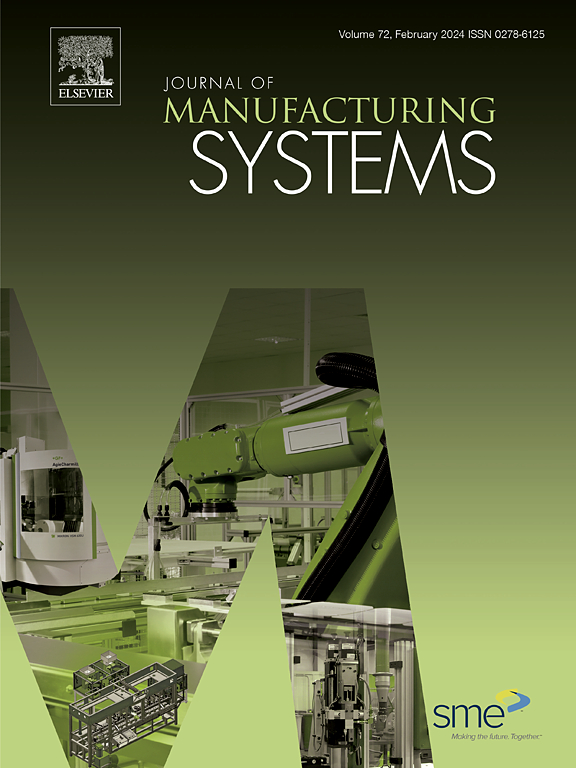MetaFactory:一个基于云的框架,用于从STEP-NC知识图配置和生成动态数据结构
IF 12.2
1区 工程技术
Q1 ENGINEERING, INDUSTRIAL
引用次数: 0
摘要
在我们之前的研究中,双晶制造已被确定为解决制造业危机的关键解决方案。在此上下文中,“数字孪生即服务”的概念要求各种孪生服务以标准化的方式相互共享和通信。STEP-NC提供了一个潜在的统一模型来促进数据交换,为数字领域中制造资源的全面表示提供了面向对象和标准化的数据模型。然而,STEP-NC的复杂性使得它在各种基于云的服务或基于pc的软件中实施起来过于繁琐。尽管经过多年的研究,这种复杂性是STEP-NC在商业CNC系统中难以找到应用的根本原因。为了克服这一技术挑战,本文引入了一个被称为“动态STEP-NC数据结构”的新概念,其灵感来自于动态编程语言(如Python)的动态语言哲学。这种方法允许不同的服务和软件包维护自己的数据定义,同时仍然与原始的STEP-NC定义保持一致。我们开发了一个名为MetaFactory的框架,它支持流线型数据结构的配置,并生成各种服务开发人员所需的相应程序代码。在此基础上,实现了STEP-NC面向对象数据库的自动建模。利用MetaFactory提供的数据裁剪和降维方法,开发了几种不同应用场景的原型系统。本文章由计算机程序翻译,如有差异,请以英文原文为准。
MetaFactory: A cloud-based framework to configure and generate dynamic data structures from the STEP-NC knowledge graph
In our previous studies, twin-oriented manufacturing has been identified as a crucial solution to address the manufacturing crisis. Within this context, the notion of “digital twin as a service” necessitates that various twin services share and communicate with each other in a standardized manner. STEP-NC offers a potentially unified model to facilitate data exchange, providing object-oriented and standardized data models for a comprehensive representation of manufacturing resources in the digital realm. However, the complexity of STEP-NC renders it too cumbersome for implementation in diverse cloud-based services or PC-based software. This complexity is a fundamental reason why STEP-NC has struggled to find application in commercial CNC systems despite years of research. To overcome this technical challenge, this paper introduces a novel concept termed “dynamic STEP-NC data structure”, inspired by the dynamic language philosophy of dynamic programming language (such as Python). This approach allows different services and software packages to maintain their own data definitions while still aligning with the original STEP-NC definition. We have developed a framework called MetaFactory that supports the configuration of streamlined data structures and generates the corresponding program code required by various service developers. On this basis, we implemented automatic modeling for a STEP-NC object-oriented database. Using the data trimming and dimensionality reduction methods provided by MetaFactory, several prototype systems for different application scenarios have been developed.
求助全文
通过发布文献求助,成功后即可免费获取论文全文。
去求助
来源期刊

Journal of Manufacturing Systems
工程技术-工程:工业
CiteScore
23.30
自引率
13.20%
发文量
216
审稿时长
25 days
期刊介绍:
The Journal of Manufacturing Systems is dedicated to showcasing cutting-edge fundamental and applied research in manufacturing at the systems level. Encompassing products, equipment, people, information, control, and support functions, manufacturing systems play a pivotal role in the economical and competitive development, production, delivery, and total lifecycle of products, meeting market and societal needs.
With a commitment to publishing archival scholarly literature, the journal strives to advance the state of the art in manufacturing systems and foster innovation in crafting efficient, robust, and sustainable manufacturing systems. The focus extends from equipment-level considerations to the broader scope of the extended enterprise. The Journal welcomes research addressing challenges across various scales, including nano, micro, and macro-scale manufacturing, and spanning diverse sectors such as aerospace, automotive, energy, and medical device manufacturing.
 求助内容:
求助内容: 应助结果提醒方式:
应助结果提醒方式:


